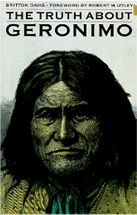

 |  |
The Truth about Geronimo
|
Please go to the new Coffee Coaster site implemented more gracefully in Wordpress. This page: http://brianrwright.com/CoffeeCoasterBlog/?p=2390 |
 This summer (2010) I was pleasantly amazed by the 1993 movie Geronimo, starring a young Matt Damon (as the author of this book: Britton Davis), Gene Hackman, Jason Patric, Robert Duvall, and Wes Studi. I love that film; my mom said she remembered seeing it closer to when it came out, and that it gave an authentic portrayal of the Indian conflicts.
Well if the movie gives a fair idea of the interplay of Indian and White cultures in late 19th century America, the book provides a stunning achievement in that area. Growing up as I did in the decade of the 1950s to John Wayne movies and plenty of Westerns—where an Indian was a Hollywood actor with dark makeup—I fashioned some of my childhood heroes from the (white) actors.
This summer (2010) I was pleasantly amazed by the 1993 movie Geronimo, starring a young Matt Damon (as the author of this book: Britton Davis), Gene Hackman, Jason Patric, Robert Duvall, and Wes Studi. I love that film; my mom said she remembered seeing it closer to when it came out, and that it gave an authentic portrayal of the Indian conflicts.
Well if the movie gives a fair idea of the interplay of Indian and White cultures in late 19th century America, the book provides a stunning achievement in that area. Growing up as I did in the decade of the 1950s to John Wayne movies and plenty of Westerns—where an Indian was a Hollywood actor with dark makeup—I fashioned some of my childhood heroes from the (white) actors.
In the 1960s and the 1970s, Hollywood and culture in general started asking questions, wondering whether truth about the American Indian Wars, and the Indians themselves, was being buried up there on the screen along with with the straight skinny about the Red White and Blue welfare/warfare state. Several movies came along to desuppress the longstanding notion that the American government were the good guys vis a vis the Indians. One that comes to mind is Little Big Man with Dustin Hoffman (1970), another, believe it or not, probably more from the 'right wing' perspective, was Eastwood's The Outlaw Josey Wales (1976):
Ten Bears: These things you say we will have, we already have.
Josey Wales: That's true. I ain't promising you nothing extra. I'm just giving you life and you're giving me life. And I'm saying that men can live together without butchering one another.
Ten Bears: It's sad that governments are chiefed by the double tongues. There is iron in your words of death for all Comanche to see, and so there is iron in your words of life. No signed paper can hold the iron. It must come from men. The words of Ten Bears carries the same iron of life and death. It is good that warriors such as we meet in the struggle of life... or death. It shall be life.
To the book, very few of us I'll imagine have read the nonfictional accounts of a soldier who was in the middle of the cultural conflict—the wars, often simply management of the peace—back in those days. And that's what 2d Lieutenant, Britton Davis, Third Cavalry, brings to the table. It's a true story! No we mustn't get carried away: every person has his points of view. But with The Truth about Geronimo all the key engagements and action can be verified through historical records. Further, you sense immediately—Davis wrote the book in 1929 at the age of 69—that the author is annoyed by all the pulp fiction and other fiction that passed for fact in journals of the time.
Doggone it, he's going to set the record straight. He was living in San Diego in the later 1920s, and became aware of how the early movie industry was taking license with the truth. In an interview with a reporter:
"I got dadblamed [not his real adjective] tired of hearing so many untruths about Geronimo and his capture that I sat down and wrote the truth about it. Geronimo was never captured."
Davis was also motivated by a longstanding controversy he had had in veterans' circles with another participant in the Geronimo campaign, General James Parker. Parker was an admirer of General George Crook's replacement, General Miles. Miles was a more willing executor of the deceitful policies of the American state toward the Southwest Indians in general, and its treatment of General Crook's (and Davis's) loyal Indian scouts in particular. Most of the Indians were sent away from their families by train to federal prison in Florida, as was Geronimo.[1]
What distinguishes Davis's story is his living day-to-day with the Indians he was sent to 'manage.' And here's a telling passage of his sentiments:
In my talks with the Indians they showed no resentment of the way they had been treated in the past; only wonderment at the why of it. Why had they been shifted from reservation to reservation; told to farm and had their crops destroyed; assured that the Government would ration them, then left to half starve; herded in the hot, malarial river bottoms of the Gila and San Carlos, when they were mountain people? These and other questions I could not answer. And above all they wondered if they would now be allowed to live at peace. Poor devils! Their fears were realized. In two years they were in prisons in Florida; four hundred innocent people, men, women, and children, who had kept the faith with us, punished for the guilt of barely one-fourth who had been lied to and frightened into leaving the Reservation by Geronimo, Chihuahua, and two or three other malcontents.
We have heard much talk of the treachery of the Indian. In treachery, broken pledges on the part of high officials, lies, thievery, slaughter of defenseless women and children, and every crime in the catalogue of man's inhumanity to man the Indian was a mere amateur compared to the "noble white man." His crimes were retail, ours wholesale. We learned his methods and with our superior intelligence, improved upon them...
Davis is a remarkable man and soldier, too, just out of the academy. He learns rapidly the lay of the land. The great majority of the book is a description, not of military campaigns, but of how life was with the Indians on the Reservation(s) and in and around the Mexican border. You learn that the discontented Indians—meaning those discontented enough to either prey on white settlements or to break free and head into the Mexican Sierra Madres (the Mexicans fought them, too)—would have been mollified, as a minimum, by yielding them decent lands for a pastoral or continued nomadic existence. As Wes Studi playing Geronimo in the movie puts it:
Geronimo: With all this land, why is there no room for the Apache? Why does the White-Eye want all land?
What clearly comes across is how the government turned the indigenous American populations into effective prisoners on their own lands. Having stated all this, reading the daily accounts of Lieutenant Davis puts a completely human context to what is going on. And of course, Davis' description of the 'capture' (the coming in) of Geronimo simply rounds out the historical truth of the era. What convinces me that Davis' account is authentic—aside from the straightforward, often humor-rich, prose—is that he often takes issue with the federal military authority. Britton Davis wound up as a businessman, managing the Corralitos Mining and Cattle Company, a property of a New York firm on the eastern flank of the Sierra Madre in Chihuahua Province, Mexico.
A great humanitarian, military read: surely closest to the way it was.
[1] Some time later, Crooks and other white military leaders who sought humane treatment of the Indian managed to reunite some of them at various federally designated locations.
###
2010 December 31
Copyright © Brian Wright | The Coffee Coaster™
Geronimo | Britton Davis | Indian Wars | Apaches | Arizona Front
 |
||||